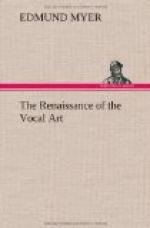Let us see what special qualifications assist in the actual performance of song, in the attempt to give pleasure or artistic gratification by singing songs for others to hear. In the first place let us consider the limitations as well as the advantages of the human voice. I must ask you to remember that considered as an instrument it is smaller in power than some instruments, shorter in range than many others, often less beautiful than the tones of the violin. But in one respect it transcends all others. It is capable of revealing the mind and soul of the one who plays upon it. The speaking voice, as well as the voice in song, reveals thought and feeling to the hearer; those subtler shades of meaning which distinguish man, made in the image of God, from his humble companions, are made clear to those about him by this instrument—this wonderful, persuasive, cajoling, beseeching, enthralling, exciting, thrilling, terrifying instrument! Have you not been moved by the tones of the speaking voice? How can we train the voice in song to express these varying shades of meaning, and can we learn to use them systematically instead of accidentally or when we are impelled by strong emotion? I know that there is a popular impression that some singers possess a mysterious quality known as “temperament,” and that others do not. Having this uncertain quality, one singer stirs an audience; having it not, the hearer remains unmoved. If by temperament, intelligence and emotional richness of nature are meant, I do not believe that anyone who is not to some extent possessed of these faculties can stir the feelings of his hearers to any considerable degree. But surely many, almost all people capable of conquering the physiological, psychological, technical, and musical difficulties to be overcome before learning to sing at all well, possess these qualities. And even if modern songs of the best type abound in subtle, emotional expression and varying shades of intellectual significance, it is, I believe, possible for most singers to gain in interpretative facility by learning to connect the thought and feeling underlying the song with the spoken words which are their natural outlet and expression.
I say spoken words; for speech is the more spontaneous expression of thought and feeling, through which individuality attains its simplest and most complete expression. Speech is the normal method through which we make clear our ordinary thoughts, feelings, desires, repulsions, and attractions to those about us. Song is the finer flower of artistic expression, one of the means through which imagination and the creative and interpretative faculties find an adequate medium and outlet. But the words of the poem, whether spoken or sung, must first be thoroughly understood before the reader or singer attempts to make anyone else comprehend or feel them. Too often an apparent lack of “temperament” is only the failure to have a definite understanding of the meaning of the words the singer is vainly endeavoring




